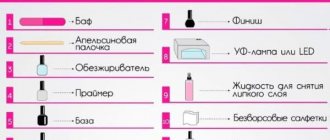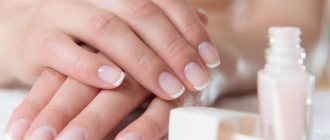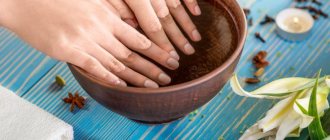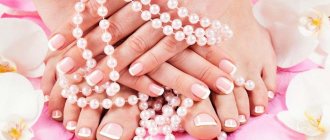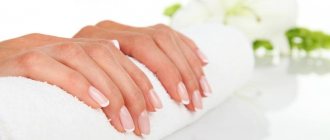Posted date: July 24, 2017
Due to the fact that modern women are trying to succeed in all areas of life, they have a catastrophic lack of time to care for their nails. The main difference between a dry manicure and the classic method of nail care is that it does not require soaking your fingers in water. A classic manicure with aromatic baths and massage is usually preferred by lovers of salon spa treatments. This is really nice, but, firstly, it takes quite a lot of time, and secondly, preparing a bath every time is not always convenient, especially if you put your hands in order yourself at home.
The variety of manicure types is impressive every day. Who would have thought that before fashionistas could limit themselves to only one traditional look. Now dry manicure, which is also called edged or European, has gained popularity. Let's try to figure out what exactly it is and why exactly it is good.
What is dry manicure?
This manicure is a way to care for your nails without using steaming. Japanese and spa manicures can also be dry, but the main and most popular is European.
First of all, masters recommend dry manicure to those who care for their nails and hands not only once, before the holidays, but regularly, at least 2 times a month.
Unedged dry manicure at home
When performing this type of manicure, the cosmetologist practically does not use scissors and tongs, and also does not steam the nails before treatment. After soaking, the marigolds absorb water and change shape, becoming flatter. When dry, they return to their natural roundness. As a result, the fresh varnish suddenly peels off and lags behind. This manicure makes it possible to maintain beautiful, well-groomed nails longer.
If your hand skin is dry
Dry skin is far from a decoration that ages our hands, adding years to them. What to do? You can improve the condition of your hand skin if you perform other types of manicure along with European manicure:
- European manicure for dry hand skin at home can be supplemented by paraffin therapy;
- At home, before a manicure, you can do a SPA for the skin of your hands, for which various peelings, scrubs, and nourishing masks are used;
- Also, you can make paraffin baths with collagen cream for the skin of your hands;
- To moisturize the skin of your hands at home, you can use natural remedies given by nature: infusions of herbs, seaweed, mud, etc.
Benefits of dry manicure
Dry manicure has become a revolution among nail artists:
- Instead of stabbing and cutting tools, only wooden sticks are used. They push back the cuticle without harming the nails. By the way, it is precisely because of this fact that the second name for manicure is European unedged.
- The varnish remains on the nails much longer;
- Minimal risk of infection. It is almost impossible to damage the skin with wooden sticks. Therefore, it is almost impossible to get an infection after a manicure.
- Dry manicure is much gentler on both nails and hand skin.
- There is no discomfort, pain or discomfort during a manicure.
- Even if you have very sensitive skin, the procedure can be repeated weekly without causing harm.
- After this manicure, hangnails do not peel off, since the skin and cuticle structure are not cut off.
- This type of manicure is suitable even for children.
- If dry manicure becomes part of your life on a regular basis, the growth of the cuticle slows down.
Dry European manicure with a file
Under the name of European manicure, you can also find on the Internet another new way of performing an unedged type of manicure - sawing. In it, almost complete treatment of nails, the skin around them, and the cuticle is performed only with files. Perhaps, such a manicure will be comparable in budget to a European one. I also recently tried it on myself and was quite surprised by its effectiveness. You can read the review in more detail in the corresponding article.
Bal professional remover provided by fiore-rus.ru store
When is this manicure relevant?

It has already been described above what positive features characterize European dry manicure. But not everyone gives it preference. Some people are used to the classic edging and don’t even think about changing their long-term habits. It is worth highlighting those cases when a dry manicure would be an ideal option:
- delicate and thin skin around the nails;
- allergy;
- if you want to keep your hands in an attractive condition, it’s easier and faster;
- if the blood capillaries are located too close;
- very thin and delicate cuticle;
- if there is a fear of getting a cut during a manicure session and becoming infected with some kind of disease;
- for children.
Disadvantages of the dry method
Dry manicure, step 3
- Unusual sensations that do not meet expectations
. It is sometimes difficult for adherents of the classical approach to get used to the fact that water is not involved in manicure and pedicure. They have a prejudice that without water there is no feeling of cleanliness. - For those who find it difficult to switch to a completely dry method (that is, no water at all), you can offer a semi-dry manicure
. It involves initial hand washing. Washing your hands is less disruptive than soaking in a bath of water for 5 minutes. - The dry method is not suitable for all nails
. For example, clients with strong and short nails may not be afraid to soak in a bath of water. The dry method is recommended for long, thin and sharp nails, while for strong and thick nails, water can, on the contrary, even help. It is better to strive for an individual approach, even in manicure and pedicure.
Set of tools
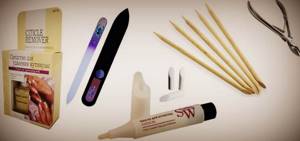
When preparing for a dry manicure, immediately forget about the baths in which you are used to steaming your nails and using scissors. You don't have to use this tool. In order to do an unedged manicure you need:
- apricot or orange sticks to treat the cuticle;
- two types of files – wide and thin. The wide one is used to create the desired shape of the nail, and the thin one is used to complete the work;
- wooden or metal rounded spatula;
- sharp nippers, needed if there are hangnails around the nails;
- napkins;
- cotton pads;
- nail polish remover, possibly with oils;
- nail oil;
- cuticle remover;
- colored nail polish;
- base for colored varnish;
- fixative
Dry combined manicure
For comprehensive care of the nail plate and hand skin, any woman can take advantage of a symbiosis of cosmetic procedures. This type of nail care does not injure the cuticle, but it is possible to trim dried calluses and side ridges on the fingers.
Disadvantages of combined nail art
- Increased time spent.
- The need to master several techniques for their successful application.
- Increasing the required tools.
- Searching for an algorithm of actions that is optimal for your nails.
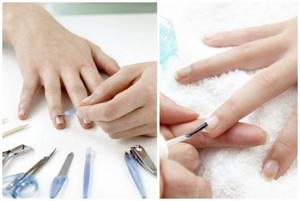
Combined manicure technology: classic and European
To combine the two most optimal options, you will need:
- orange stick;
- metal spatula (pusher);
- nippers and scissors;
- cuticle remover;
- files of varying degrees of hardness;
- buff for polishing plates;
- cuticle oil, cotton pads.
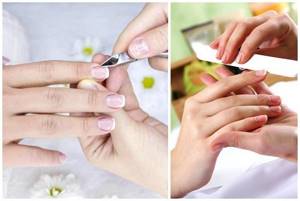
Instructions for action:
- Use an iron spatula to push back the cuticle.
- Apply remover to the root of the nail and wait 10 minutes.
- Clean cuticles with an orange stick.
- Wipe the surface of the nail plate with a disinfectant.
- Using scissors or nippers, clean the lateral periungual areas of the skin, removing irregularities and hangnails.
- Polish the surface and give your nails the desired shape with a hard nail file.
- The final touch is to apply varnish, you can use El Corazon Varnish, it has healing and nourishing effects.
Before mastering how to do a combined manicure, you should do each of its component parts separately several times.
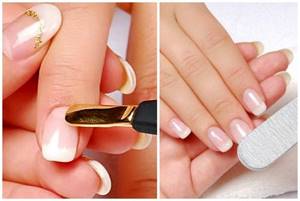
In order not to embarrassly hide your hands behind your back when the attention of a stranger is drawn to your hands, we suggest the most acceptable method of hand care - dry manicure. The procedure has already won thousands of fans around the world with its gentle effect and amazing results.
Manicure process

In general, the unedged manicure procedure lasts no more than 45 minutes. Everything, as usual, begins with disinfection of the hands of the master and client. Next, the master, using nail polish remover without acetone, removes the previous nail coating. Use a nail file to model the desired shape of your nails.
The next step is to apply a special liquid with fruit or lactic acids to the cuticle to soften it and slow down growth. Wait 5-7 minutes. After the cuticle has softened and become pliable, it is removed with a wooden stick. Remains of dead skin are removed with a damp corner of a clean towel. Nourishing oils are applied to the nail plate and rubbed in with massage movements. At the client's request, varnish is applied.
The final stage is a hand massage using a nourishing cream to speed up blood circulation.
Dry hardware manicure as a type of European unedged
European unedged manicure, in addition to manual, can be hardware. The device, in appearance and in its operating principle, may resemble a medical drill. The nozzle at the tip rotates quickly and thus affects the nail plate. A dry manicure differs from a regular hardware manicure only in that the hands do not need to be steamed first. Algorithm:
- Old nail polish is removed with nail polish remover, preferably one that does not contain acetone.
- Rub emulsion into the cuticle to soften the cuticle and remove it with a stick.
- The device is held in the same way as a ballpoint pen; you can only work with dry hands.
- Under no circumstances should the device be pressed tightly against the nail bed, as this can injure the skin.
- Medium abrasive attachments are designed to remove dead skin from nail folds.
- A nozzle resembling a small ball removes the cuticle.
- Low abrasive attachments are needed to remove dry calluses.
- After treating the nails with the device, a caring cream is applied to the hands.
European manicure with coating
If after a manicure you want to apply a decorative coating - varnish or gel polish, then you do not need to do any care procedures. Immediately after processing the cuticle, begin (after step 6 in the instructions described above) to prepare the nail surface if you are doing gel polish or applying nail polish.
I did a gel polish coating like this a little later.
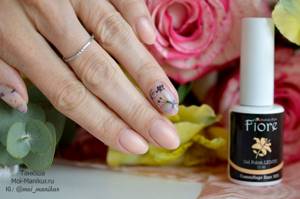
There is already an article on this design and the camouflage base used on my blog.
If you are covering your nails immediately after a manicure, then rub in the cuticle oil after finishing the coating.
Manicure with dry glitter at home

There are different types of glitter for manicure. And so, when it comes to shiny varnish, then there are no questions about how to proceed. There are several methods for doing a manicure with dry glitter. It may not work out perfectly the first time, but a few training sessions and you will be able to give up salon procedures.
Option 1. Initially, the nail is covered with a base layer of varnish. Use a dry brush to pick up glitter and shake off the particles onto the varnish that has not yet dried. The manicure ends with a finishing coat.
Option 2. The brush is dipped into the varnish, and then into a container with glitter. After this, apply glitter varnish evenly to the nail plate.
Option 3. Nails are painted with colored varnish. When it dries, the design is applied with transparent varnish. While the polish is still wet, shake off glitter onto the nail. Those that do not get on the transparent varnish are swept off the nail with a brush.
Option 4. The nail or part of it is covered with transparent varnish. After this, you need to dip your finger into the bowl with sparkles. They will stick to the painted part of the nail. For example, this option is very convenient if you make a shiny jacket.
Option 5 . A separate type of glitter is glitter. The particles in it are much larger than those we are used to. In this case, the following may be useful for manicure: hairpins, sticks or needles. Immediately after applying the varnish, you need to take the glitter one by one with a handy object and carefully apply it to where you want to fix it on the nail plate.
Home manicure ideas
Manicure with dots is performed using a special “dots” tool, similar to a needle with a ball at the end. It is sold at any nail store. To replace the dotsu, take a toothpick or hairpin. Prepare a base varnish and several contrasting color varnishes for dots, dots. Apply base polish to your nails and let it dry. Using a dot or similar, apply dots on the nail next to each other or in a strict order. It all depends on your imagination.
Water manicure
A bright, bold, unusual water manicure draws attention to your nails.
Prepare nail polishes that match in color, a container of water at room temperature, a product to protect the skin around the cuticles or hand cream, cotton pads, nail polish remover, toothpicks.
Apply a special protective agent or hand cream around the cuticles. Add one drop of varnish to a container of water one at a time in the intended order.
Swipe the toothpick several times in different directions over the varnish in the water. No more than 1 minute should pass from the first drop to the finished drawing. Place your nail parallel to the plane of the water in the center of the design.
Allow time to dry, remove excess polish around the cuticle. Repeat the procedure for each nail.
Next: in detail how to do a water manicure.
Lunar manicure at home
He returned from the 30s of the last century. At that time, it was not customary to cover the entire nail with varnish; fashionistas left the hole at the base uncovered. Hence the name - lunar.
Prepare 2 polishes in contrasting colors and stencils (available at a nail store).
Apply polish to the nail color that will be at the base of the nail and allow time to dry. Place the stencils on the nails at the hole and apply the main color of the polish. Give the polish time to dry and carefully remove the stencils from your nails.
Next: how to do a moon manicure yourself.
Matte manicure
The fastest way to get an unusual home manicure.
Prepare a glossy varnish, without glitter or pearl, in a pan of boiling water.
Apply polish to your nails. Without waiting for drying, hold your nails over steam at a height of 15 cm for 10-15 seconds. Manicure is ready.
Magnetic manicure
Another simple and effective manicure at home.
Thanks to the invention of a varnish in 2007, which contains metal particles, magnetic nail polishes appeared on the market. Immediately after applying the varnish, by bringing special magnetic strips to the nail, you can achieve unique patterns - grid, diagonal, stripes, rays, stars. You can buy magnetic stripes together with varnish or in separate sets.
Suggest your ideas in the comments! And we have another excursion into home manicure from a course participant.
Contraindications and side effects
Correctly performing a dry European manicure is not as easy as it seems, especially if it is a hardware one. As a rule, the majority of clients, out of habit, choose an edger, and many craftsmen simply do not have enough hands to do such work.
A master without experience or the necessary skills can cause serious harm to his client. When polishing the nail or pushing back the cuticle, you can seriously damage the nail plate, even leaving large grooves on it. In addition, if the master is incompetent, the procedure can be quite painful, especially when using a device for hardware dry manicure. A person may feel unpleasant vibrations and a strong burning sensation.
An important feature of dry manicure is that it does not leave the cleanliness that a classic edged manicure can provide. Steaming the skin makes it possible to completely remove the entire cuticle; it is almost impossible to do this with an orange stick.
Dry manicure is not recommended if your nails are neglected; to get them in order you need to steam your hands and cut off dead skin.
In order for an unedged manicure to be of high quality and not cause harm, you need to take a responsible approach to choosing a specialist and not skimp on it.
Tools and materials
In terms of the set of materials and tools necessary for European manicure, this method of nail treatment is the cheapest, most accessible and easy to do on your nails at home. To do this you will need to have:
- File for natural nails . Every girl has one of these in her makeup bag. It is used to correct the shape and length of nails. Additionally, you can separately use a slightly harder file to treat rough skin around the nails. Some people use pumice for these purposes. If you want to have glossy shiny nails, then also get a polishing file.
- Means for softening and removing cuticles (remover). They are easy to find in any cosmetics store in a variety of forms. On my blog I have already reviewed some of these tools, for example, in the form of a pencil or with a pipette. Their cost is not at all high, and one bottle lasts quite a long time even with regular use.
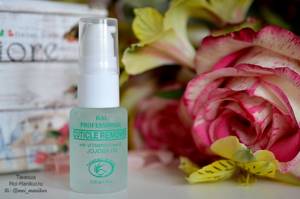
- Orange sticks . They are thin wooden sticks made from orange wood and have an antiseptic effect. One of the ends of the stick has a sharp shape - it is convenient for cleaning the space under the nail. The second is beveled, to remove softened cuticle. Instead of orange sticks, you can buy apricot sticks. They are disposable and are used not only for the European manicure procedure, so you can immediately buy a set of 50 or 100 pieces - there is no expiration date. From my experience in European manicure, I can say that one such stick is enough for me to treat one hand.
- Cuticle oil . Rubbing this product completes the treatment of the cuticle in any type of manicure.
One remover, oil, file and orange sticks will be enough for a European manicure. Of course, the list of tools and tools can be expanded to suit your needs:
- Instead of orange sticks, you can use a pusher (manicure spatula) with a hatchet at the other end. Some may like that it is reusable, but it can scratch your nail (and if you follow all the rules, it must be disinfected, even if you are the only one using the tool). And it’s not for nothing that European manicure is considered the safest and most gentle, which is why it is recommended to choose wooden sticks.
- Instead of remover, you can soften the skin in a warm bath with soapy water. Then you will need an appropriate water container to fit your hand.
- For additional care, you can use special products, such as nail wax, hand cream, scrub and other benefits that you want to pamper your nails and hands with.
Review
Olga, 45 years old. Ekaterinburg During my life I have tried a lot of different manicures. My blood vessels are located very close to the skin, so every trip to the specialist ended in wounds and unpleasant painful sensations. In one of the programs I learned that such wounds can also cause infection. For some time I tried to do everything at home on my own, because I am confident in my tools. But very quickly the appearance of my nails deteriorated. A friend advised me to go for a dry manicure. I was in a negative mood. But I went. For about 40 minutes the girl-master worked magic on my hands, and I did not take my eyes off her work, expecting cuts and blood. But they were not there. I left the master with beautiful hands without a single cut. Since then, only dry manicure. It became a pleasant discovery for me and I’m not ready to exchange it back for a trim manicure yet.



